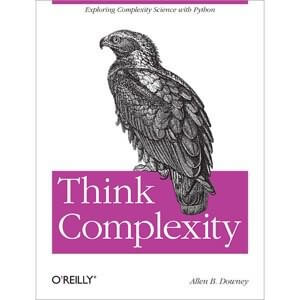Think Complexity
Expand your Python skills by working with data structures and algorithms in a refreshing context—through an eye-opening exploration of complexity science. Whether you’re an intermediate-level Python programmer or a student of computational modeling, you’ll delve into examples of complex systems through a series of exercises, case studies, and easy-to-understand explanations.
You’ll work with graphs, algorithm analysis, scale-free networks, and cellular automata, using advanced features that make Python such a powerful language. Ideal as a text for courses on Python programming and algorithms, Think Complexity will also help self-learners gain valuable experience with topics and ideas they might not encounter otherwise.
Work with NumPy arrays and SciPy methods, basic signal processing and Fast Fourier Transform, and hash tables
Study abstract models of complex physical systems, including power laws, fractals and pink noise, and Turing machines
Get starter code and solutions to help you re-implement and extend original experiments in complexity
Explore the philosophy of science, including the nature of scientific laws, theory choice, realism and instrumentalism, and other topics
Examine case studies of complex systems submitted by students and readers
Table of Contents
Chapter 1. Complexity Science
Chapter 2. Graphs
Chapter 3. Analysis of Algorithms
Chapter 4. Small World Graphs
Chapter 5. Scale-Free Networks
Chapter 6. Cellular Automata
Chapter 7. Game of Life
Chapter 8. Fractals
Chapter 9. Self-Organized Criticality
Chapter 10. Agent-Based Models
Chapter 11. Case Study: Sugarscape
Chapter 12. Case Study: Ant Trails
Chapter 13. Case Study: Directed Graphs and Knots
Chapter 14. Case Study: The Volunteer’s Dilemma
Appendix. Call for Submissions
Appendix. Reading List
Book Details
Paperback: 158 pages
Publisher: O’Reilly Media (January 2012)
Language: English
ISBN-10: 1449314635
ISBN-13: 978-1449314637




